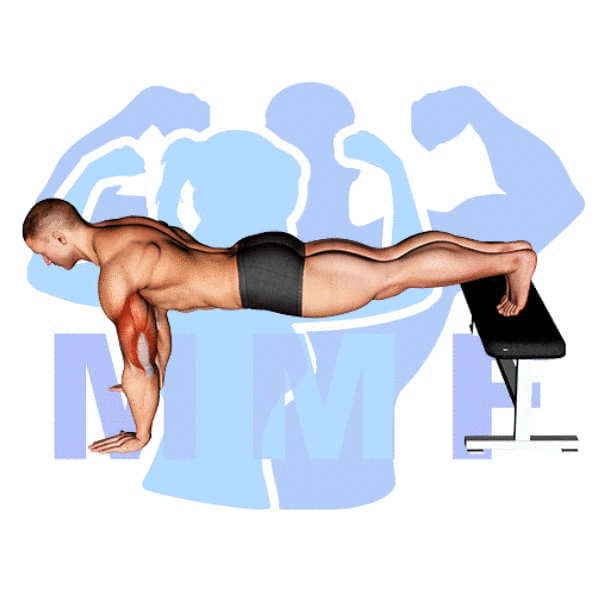Are you struggling to properly execute a dumbbell squat? Don’t worry, you’re not alone. Many beginners have trouble with maintaining proper form while performing this exercise. It’s easy to get lost in the hype and excitement of starting a new fitness routine, but it’s important to give yourself time to learn. The good news is that with a little practice and guidance, you can master the dumbbell squat. In this post, we’ll cover some tips and tricks to help you perfect your form and get the most out of this powerful exercise.
Dumbbell Squat Summary
- Primary Muscles: Quadriceps
- Secondary Muscles: Adductor Magnus, Gluteus Maximus, and Soleus
- Equipment: Dumbbells
- Mechanics Type: Compound
- Force: Push
- Utility: Basic

Dumbbell Squat Instructions
- Grab your dumbbells and let them hang to your side.
- Squat down by simultaneously bending at your hip forward and your knees back.
- Lower your rear util your quads are flat or as low as your knees will let you comfortable go.
- Then, press back put to your standing position.
- Continue until you have accomplished a whole set.
Video Tutorial
Dumbbell Squat Muscles
Target (Agonist)
Synergists
- Adductor Magnus
- Gluteus Maximus
- Soleus
Dynamic Stabilizers
Stabilizers
- Erector Spinae
- Levator Scapulae
- Trapezius – Middle
- Trapezius – Upper
Antagonist Stabilizers

Benefits of Dumbbell Squat
The dumbbell squat is a great exercise for developing the Quadriceps muscle group, which is one of the most important muscles for overall lower body strength. It activates all four heads of the Quadriceps, strengthening and toning them, as well as improving balance and stability. The dumbbell squat also works the glutes, hamstrings, and core muscles, making it a comprehensive lower body exercise. Performing this exercise regularly can help to increase strength, power, and muscular endurance, as well as improve posture and mobility. Furthermore, the dumbbell squat is an excellent tool for building muscle mass, burning fat, and improving overall fitness.
Tips for Performing Dumbbell Squat
When you need to develop the optimum strength gains, you will want to abide by these simple and easy tips. Additionally, when you wish to protect yourself against an injury, you would be wise to understand these tips.
- Do A Correct Warm-Up Prior To You Start To Add Any Heavy Weight. Not appropriately doing a warmup executing a proper warm up is the most frequent way to injure yourself.
- Always Keep A Lifting Journal. You should certainly keep a journal of all weights, sets and repetitions. If you are really efficient you will also note your rest durations. Right now there are a great deal of high-quality apps to use a log, or you could simply utilize a small pocket book.
- Slow Each Repetition Down For Greater Strength Gains. By Raising the time under tension you are engaging your muscles more and they will respond by increasing more muscle. You can achieve this without increasing the resistance by doing slow reps approximately 4 – 6 seconds flexing and pause then 4 – 6 seconds expanding.
- Work out By A Place Where You Can Look At Your Form In A Mirror. You are looking to have the capability to always keep solid form on each rep, so you can do just that you have to have a way to look at and fix your technique.
- To Improve Power And Speed, Bring Up The Rate Of Your Movements. Preserve good form or you will be more suboptimal to personal injury. You must lower the weight to 50 to 60 percent of your single rep max weight when training for speed. Additionally, you will need to pause in between each repetition.
- Breathe In While You Stretch Your Muscle Tissues And Exhale When You Flex Your Muscle Tissues.
- Exercise Near A Place Where You Will Be Able To Examin Your Technique In A Mirror. You are looking to have the ability to retain effective technique on every repetition, so as to make this happen you have to be able to to look at and fix your form.
- help reduce muscle soreness by carrying out a few minutes of cardio exercise directed at your target muscle groups at the end of your session. This cardiovascular exercise is removing much of the lactic acid. Therefore you will undoubtedly be enhancing your healing.
Benefits and Tips Video
Frequent Mistakes To Avoid
You must refrain from these typical issues to build and maintain nice technique and see large gains. Furthermore, when you stay away from these problems you will reduce the prospect of having an injury.
- You Don’t Want To Rush Your Workout. Every time you speed through your workout you are liable to have bad form and accidents.
- Don’t Allow Yourself To Cheat. In most the time, cheating is utilizing momentum as a substitute for the strength of your primary muscle. Once in a while, a bit cheating on your final rep can be beneficial to overload your muscle, although not for more than a couple of reps.
- Don’t Relax Your Stomach. Keeping your abs flexed to protect your spinal column by maintaining your internal pressure.
Find More Dumbbell Exercises Here
Variations and Complementary Exercises
If you’re looking for more exercises that can provide similar benefits as the Dumbbell Squat, there are a variety of variations, complementary, and alternative exercises to choose from. The following list outlines several options that you can try out to mix up your routine.
Lever Full Squat (Machine)

The Lever Full Squat (Machine) is a great complementary exercise to Dumbbell Squat, as it allows the user to safely perform a lower body workout with heavier weights. This machine allows the user to safely control the range of motion, reducing the risk of injury, while also providing the user with an intense workout. Furthermore, the Lever Full Squat Machine can target both the quadriceps and the glutes, providing a full-body workout. In contrast to the Dumbbell Squat, the Lever Full Squat Machine eliminates the need for a spotter and can also be done with heavier weights. All in all, this machine is a great alternative or complementary exercise to the Dumbbell Squat.
Lever Squat (Machine)
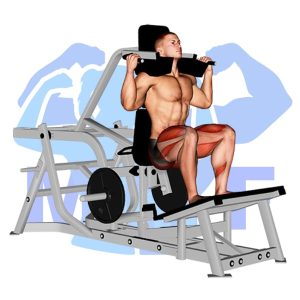
The Lever Squat Machine is a great alternative or complementary exercise for the Dumbbell Squat. This machine is designed to provide a more controlled motion, and it also allows for more weight to be used compared to a dumbbell squat. The Lever Squat Machine allows you to move the weight up and down with a smooth and controlled motion. This machine also helps to reduce the risk of injuries due to its stability and control. Additionally, it can be adjusted to accommodate different body sizes and levels of fitness. Therefore, if you are looking for a way to increase the intensity of your squat routine, the Lever Squat Machine is an excellent choice.
Prisoner Squat
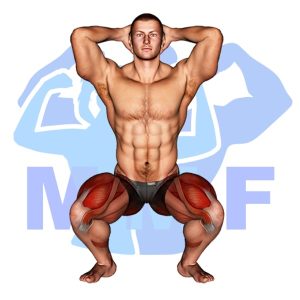
Prisoner Squat is an effective exercise for strengthening the legs and glutes and can be used as a complementary or alternative to Dumbbell Squat. The exercise is performed without any equipment and is great for those who are looking for a no-equipment exercise that can be done anywhere. Unlike Dumbbell Squat, Prisoner Squat does not require the use of weights and the range of motion is slightly different. The Prisoner Squat focuses more on the posterior chain and engages the glutes, hamstrings, and lower back more than a regular Dumbbell Squat. It is an excellent exercise for those looking to increase their leg strength and stability.
Check Out These Top Dumbbell Exercises
Smith Machine Clean Grip Front Squat

The Smith Machine Clean Grip Front Squat is a great complementary or alternative exercise to the Dumbbell Squat. This exercise allows you to work your quads, hamstrings, glutes, and core while providing stability and control. The clean grip allows you to keep your chest up and maintain a proper squat position. The Smith Machine also helps you to keep your balance and control the weight more easily than with the Dumbbell Squat. Additionally, the barbell on the Smith Machine can also be used for a variety of other exercises that are not possible with dumbbells. Ultimately, the Smith Machine Clean Grip Front Squat is an effective exercise for building strength, power, and overall leg development.
Smith Machine Frankenstein Squat
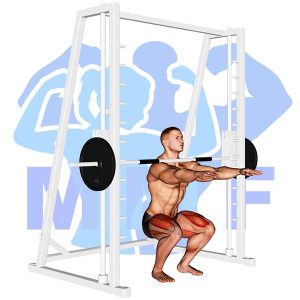
The Smith Machine Frankenstein Squat is a great alternative or complementary exercise to the Dumbbell Squat. It allows you to use heavier weight than you would be able to with a Dumbbell Squat while still maintaining proper form and range of motion. The Smith Machine Frankenstein Squat works the same muscles as the Dumbbell Squat, but also has the added benefit of allowing you to isolate and target specific muscle groups. This makes it ideal for training specific muscle groups, such as glutes and hamstrings, while still getting the benefits of a full body workout.
Smith Machine Front Squat

The Smith Machine Front Squat is an excellent complementary or alternative exercise to the Dumbbell Squat. It uses a barbell secured in a Smith Machine, and the lifter stands in front of the bar and squats down to a full depth. This exercise focuses on quadriceps, glutes, and core muscles, and it allows for heavier weights to be used than with the Dumbbell Squat. It also provides stability and control of the bar path, which can help lifters who have difficulty performing free weight squats. The Smith Machine Front Squat is a great exercise to add to any leg day routine.
Find More Legs Exercises Here
Opposing Complementary Exercises
If you are looking to add exercises to your workout routine to complement the Dumbbell Squat, here are a few exercises that target the opposing muscle groups. By engaging opposing muscle groups, you will improve your balance and stability and reduce the risk of injury.
Lunge

The Lunge is an effective exercise that complements the Dumbbell Squat by targeting the opposing muscle group. The Lunge works the quads, glutes, and hamstrings, while the Dumbbell Squat targets the hip flexors and core. By performing both exercises, you can increase your overall lower body strength, balance, and stability. The Lunge also improves your coordination and helps to improve your posture. It can also help to increase the range of motion in your hips and legs. Additionally, the Lunge helps to increase your metabolism, so it can be beneficial for weight loss and improving overall body composition.
Rear Lunge
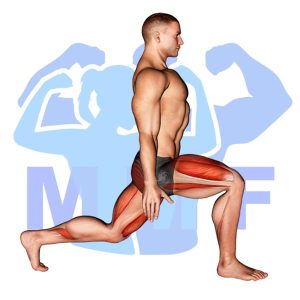
Rear Lunge is the perfect complementary exercise to Dumbbell Squat as it works the opposing muscle group. It is an effective way to build strength and stability in the lower body, working the glutes, quadriceps, hamstrings, and calves. This exercise helps to engage the hip extensors that are not used in a traditional squat movement. By working the opposite muscle groups, Rear Lunge helps to create balance and stability for the body, allowing for a more effective workout.
Walking Lunge
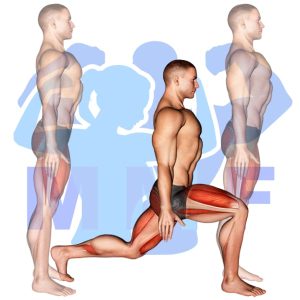
Walking Lunge is an excellent complementary exercise to Dumbbell Squat as it targets the opposing muscle group. By alternating between these two exercises, you are able to work both the quadriceps and the hamstrings, allowing for a full body workout. The Walking Lunge also engages the core muscles while challenging the balance of the body. Additionally, it is an effective way to increase mobility and flexibility, as well as improve coordination and stability. As a result, pairing these two exercises will help to maximize muscular development and overall fitness.
Power Up Your Squat Game With Dumbbells!
Introducing dumbbells into your squat routine can significantly improve your overall strength and power. By holding the weights at your sides during the squat, you engage more muscles in your core, glutes, and legs, resulting in a more intense workout. Dumbbell squats can also provide added balance and control during the movement, reducing the risk of injury. Whether you’re a fitness enthusiast or a beginner, incorporating dumbbells into your squat routine can elevate your workout to the next level.
References: Wikipedia | ExRx.net | PubMed.gov | Comprehensive List of Legs Dumbbell Exercises


